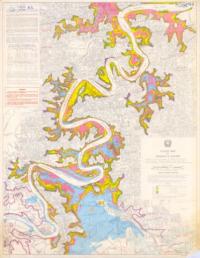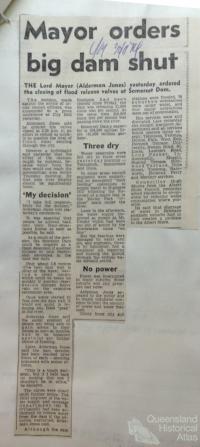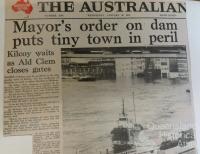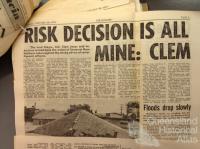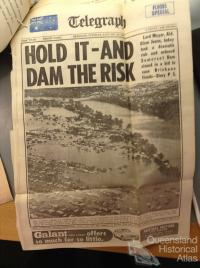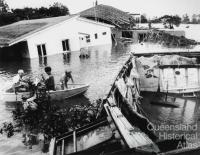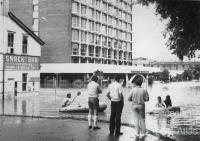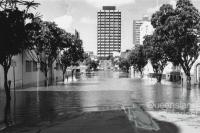- Home
- Quintessential Queensland
- Distinctiveness
- Perceptions
- Perceptions: how people understand the landscape
- From runs to closer settlement
- Geological survey of Queensland
- Mapping a new colony, 1860-80
- Mapping the Torres Strait: from TI to Magani Malu and Zenadh Kes
- Order in Paradise: a colonial gold field
- Queensland atlas, 1865
- Queensland mapping since 1900
- Queensland: the slogan state
- Rainforests of North Queensland
- Walkabout
- Queenslanders
- Queenslanders: people in the landscape
- Aboriginal heroes: episodes in the colonial landscape
- Australian South Sea Islanders
- Cane fields and solidarity in the multiethnic north
- Chinatowns
- Colonial immigration to Queensland
- Greek Cafés in the landscape of Queensland
- Hispanics and human rights in Queensland’s public spaces
- Italians in north Queensland
- Lebanese in rural Queensland
- Queensland clothing
- Queensland for ‘the best kind of population, primary producers’
- Too remote, too primitive and too expensive: Scandinavian settlers in colonial Queensland
- Distance
- Movement
- Movement: how people move through the landscape
- Air travel in Queensland
- Bicycling through Brisbane, 1896
- Cobb & Co
- Journey to Hayman Island, 1938
- Law and story-strings
- Mobile kids: children’s explorations of Cherbourg
- Movable heritage of North Queensland
- Passages to India: military linkages with Queensland
- The Queen in Queensland, 1954
- Transient Chinese in colonial Queensland
- Travelling times by rail
- Pathways
- Pathways: how things move through the landscape and where they are made
- Aboriginal dreaming paths and trading ways
- Chinese traders in the nineteenth century
- Introducing the cane toad
- Pituri bag
- Press and the media
- Radio in Queensland
- Red Cross Society and World War I in Queensland
- The telephone in Queensland
- Where did the trams go?
- ‘A little bit of love for me and a murder for my old man’: the Queensland Bush Book Club
- Movement
- Division
- Separation
- Separation: divisions in the landscape
- Asylums in the landscape
- Brisbane River
- Changing landscape of radicalism
- Civil government boundaries
- Convict Brisbane
- Dividing Queensland - Pauline Hanson’s One Nation Party
- High water mark: the shifting electoral landscape 2001-12
- Hospitals in the landscape
- Indigenous health
- Palm Island
- Secession movements
- Separate spheres: gender and dress codes
- Separating land, separating culture
- Stone walls do a prison make: law on the landscape
- The 1967 Referendum – the State comes together?
- Utopian communities
- Whiteness in the tropics
- Conflict
- Conflict: how people contest the landscape
- A tale of two elections – One Nation and political protest
- Battle of Brisbane – Australian masculinity under threat
- Dangerous spaces - youth politics in Brisbane, 1960s-70s
- Fortress Queensland 1942-45
- Grassy hills: colonial defence and coastal forts
- Great Shearers’ Strike of 1891
- Iwasaki project
- Johannes Bjelke-Petersen: straddling a barbed wire fence
- Mount Etna: Queensland's longest environmental conflict
- Native Police
- Skyrail Cairns (Research notes)
- Staunch but conservative – the trade union movement in Rockhampton
- The Chinese question
- Thomas Wentworth Wills and Cullin-la-ringo Station
- Separation
- Dreaming
- Imagination
- Imagination: how people have imagined Queensland
- Brisbane River and Moreton Bay: Thomas Welsby
- Changing views of the Glasshouse Mountains
- Imagining Queensland in film and television production
- Jacaranda
- Literary mapping of Brisbane in the 1990s
- Looking at Mount Coot-tha
- Mapping the Macqueen farm
- Mapping the mythic: Hugh Sawrey's ‘outback’
- People’s Republic of Woodford
- Poinsettia city: Brisbane’s flower
- The Pineapple Girl
- The writers of Tamborine Mountain
- Vance and Nettie Palmer
- Memory
- Memory: how people remember the landscape
- Anna Wickham: the memory of a moment
- Berajondo and Mill Point: remembering place and landscape
- Cemeteries in the landscape
- Landscapes of memory: Tjapukai Dance Theatre and Laura Festival
- Monuments and memory: T.J. Byrnes and T.J. Ryan
- Out where the dead towns lie
- Queensland in miniature: the Brisbane Exhibition
- Roadside ++++ memorials
- Shipwrecks as graves
- The Dame in the tropics: Nellie Melba
- Tinnenburra
- Vanished heritage
- War memorials
- Curiosity
- Curiosity: knowledge through the landscape
- A playground for science: Great Barrier Reef
- Duboisia hopwoodii: a colonial curiosity
- Great Artesian Basin: water from deeper down
- In search of Landsborough
- James Cook’s hundred days in Queensland
- Mutual curiosity – Aboriginal people and explorers
- Queensland Acclimatisation Society
- Queensland’s own sea monster: a curious tale of loss and regret
- St Lucia: degrees of landscape
- Townsville’s Mount St John Zoo
- Imagination
- Development
- Exploitation
- Transformation
- Transformation: how the landscape has changed and been modified
- Cultivation
- Empire and agribusiness: the Australian Mercantile Land and Finance Company
- Gold
- Kill, cure, or strangle: Atherton Tablelands
- National parks in Queensland
- Pastoralism 1860s–1915
- Prickly pear
- Repurchasing estates: the transformation of Durundur
- Soil
- Sugar
- Sunshine Coast
- The Brigalow
- Walter Reid Cultural Centre, Rockhampton: back again
- Survival
- Survival: how the landscape impacts on people
- Brisbane floods: 1893 to the summer of sorrow
- City of the Damned: how the media embraced the Brisbane floods
- Depression era
- Did Clem Jones save Brisbane from flood?
- Droughts and floods and rail
- Missions and reserves
- Queensland British Food Corporation
- Rockhampton’s great flood of 1918
- Station homesteads
- Tropical cyclones
- Wreck of the Quetta
- Pleasure
- Pleasure: how people enjoy the landscape
- Bushwalking in Queensland
- Cherbourg that’s my home: celebrating landscape through song
- Creating rural attractions
- Festivals
- Queer pleasure: masculinity, male homosexuality and public space
- Railway refreshment rooms
- Regional cinema
- Schoolies week: a festival of misrule
- The sporting landscape
- Visiting the Great Barrier Reef
By:
Margaret Cook At the height of the 1974 floods the Lord Mayor of Brisbane, Alderman Clem Jones, ordered the gates of Somerset Dam be shut to prevent the release of floodwaters defying the recommendations of the dam operators. An urban myth developed that Clem Jones saved Brisbane. But did he?
Somerset Dam
Somerset Dam, completed in 1959, was constructed on the Stanley River, a tributary of the Brisbane River, as a dual purpose structure to provide a water supply and to mitigate flooding in the downstream areas, particularly in Brisbane and Ipswich. In 1974 it was the only structure in the system that could provide any significant flood mitigation. As Cyclone Wanda’s associated monsoonal trough dumped 681 mm of rain on Brisbane over three days from 24 January 1974, the Brisbane River steadily rose, augmented by the Stanley and Bremer River flood water and metropolitan creeks. On 1.30 pm on 28 January the flood height reached 6.4 metres on the Port Office gauge. Thirty minutes later, Somerset Dam’s gates were opened to discharge the building floodwaters, in accordance with the dam’s design intent and operating manual. Community consensus thought it madness to release more water during a flood.
Clem Jones intervenes
Around midnight on 28 January Alderman Clem Jones, rang the office of Bernie O’Connell, the Brisbane City Council Chief Engineer, demanding the Somerset Dam gates be closed to free Ipswich and Brisbane immediately from the floodwater. Council staff explained that the Stanley River flood waters must be held by the dam and then released slowly by gates after the Upper Brisbane River flood peak passed downstream of the Stanley Junction. Slow release prevented additional flood waters damaging Ipswich and Brisbane. As released water took 36 hours to reach the upper limits of Brisbane, 48 to the central business district, gate closure would have no immediate impact. Once the flood passed, the gates would be closed slowly to prevent river bank collapses as the water levels fell, leaving the water supply storage full and the flood storage empty in readiness for the next flood. The current strategy would free dwellings as quickly as possible without increasing damage in Kilcoy and Esk. Immediate release was necessary as further rain was forecast, putting a full dam at risk of destruction or flooding thousands downstream. The Lord Mayor would have none of it. The dam gates must be shut to save Brisbane. Clem Jones and his staff argued all night.
Clem Jones pulled rank. He insisted that as an elected representative and Lord Mayor he must be obeyed. The Chief Engineer consented to close the gates, Clem Jones accepting full responsibility for the consequences. At 11am on 29 January Clem Jones called a press conference, announcing the closure of the Somerset Gates at 2.30 pm. ‘I take full responsibility for the decision’, . . . ‘taken against the strong advice of senior Council officers’ . . . [but] . . .’under the circumstances, we should take a calculated risk’. ‘This is a tough decision, but if I hold back on making this one I shouldn’t be in office’.
At 3 pm on 29 January the flood level in the Brisbane River started to drop rapidly as hydrologists had predicted it would on the outgoing tide. Clem Jones, proclaimed to be the hero, he had defied the bureaucrats and saved Brisbane, a story that has survived subsequent decades.
The motivation
Two key questions emerge. Why did Clem Jones order the closure? Then why did he wait? Clem Jones’s behaviour was characteristic of him. His admirers described him as energetic, intellectually astute, decisive, visionary, an impressive media campaigner and formidable debater, while his detractors labelled him arrogant, dictatorial and inflexible. He demanded unswerving loyalty from his caucus and staff, acted without consultation and faced with dissension could resort to volcanic outbursts of intimidation and abuse. He was a solutions-driven politician and wanted to be seen as effective in saving Brisbane from flood.
Former Brisbane City Council engineer, Geoffrey Cossins, suggests Clem Jones may have been ill-advised by the Irrigation Commissioner about the efficacy of his strategy. However, Brisbane City Council officers advised Jones of the 36 hours delay between gate closure and impact in Brisbane. Clem Jones predicted that flood levels would fall, with a flood warning at 2 pm on 28 January reporting that floods in the Bremer River and Brisbane River above Mt Crosby were receding and that Brisbane river levels would remain stationary between 2 am and 4 pm on Tuesday. The 5am flood warning on 29 January forecast a lower flood peak on the high tide at 2 pm. Clem Jones seized his opportunity, timing the gates closure for 30 minutes beforehand ensuring almost instant effect. In reality closure would have little effect in Brisbane until noon, 31 January.
Closure started at 2.00 pm and despite Clem Jones’ further intervention to have the gates shut immediately rather than gradually, the Chief Engineer stood firm and the gates were finally fully shut at 2.15 am on 30 January. Somerset Dam was at full capacity for six days, with no ability to mitigate any subsequent floodwaters.
The effect
Rather than save Brisbane, hydrologists argued that Clem Jones put the city at great risk. On 5 February 1974 Cyclone Pam, ‘one of the biggest cyclones on record’, developed 600 km east of Tewantin but fortunately remained approximately 600 km off the coast. If it had crossed the upper catchment with drenching rains, it would have caused catastrophic floods as Somerset Dam had no mitigation capacity. The closure of the gates could not, and did not, reduce flood levels in Ipswich and Brisbane as Clem Jones claimed.
Furthermore, Clem Jones put Kilcoy, a town in the Upper Brisbane River catchment, immediately upstream of Somerset Dam, ‘in peril’. Kilcoy Shire Chair, Councillor M.H. McAuley, branded the decision ‘irresponsible’. Lake Somerset reached a record level of 106.7m, with the water entering Kilcoy. Houses were evacuated, 12 flooded and the town was isolated for a week. Fuelling existing tension between Brisbane and Kilcoy, Clem Jones defended his decision. ‘I took the risk – a small number of homes in Kilcoy could suffer when hundreds of homes would be helped in Brisbane’. When Clem Jones ordered the gates be re-opened, his justification seemingly contradicted his earlier decision. ‘It would be two days before the water backlog reached Brisbane and then it would no longer be a threat to the city’. Somerset Dam’s gates were re-opened on 31 January. Councillor McAulay declared ‘I’m pleased common sense has prevailed’.
In Parliament Clem Jones’ critics decried his actions as a ‘great political gesture’, ‘grand-standing in an attempt to gain some cheap political mileage from the disaster’, a cynical ploy to win urban votes at the expense of Kilcoy when he knew the decision would have no effect.
The legacy
In the aftermath of the 1974 floods the State Government introduced legislation that the person in charge of flood operations for all dams should be a qualified and experienced engineer, thereby removing political influence. In times of survival the action of any political leader is under intense scrutiny. Decisions such as these would henceforth be left to ‘experts’, but the controversy continued with each subsequent flood.
References and Further reading (Note):
John Cole, Shaping a City: Greater Brisbane 1925-1985. Brisbane: William Brooks Queensland, 1984
References and Further reading (Note):
Geoffrey Cossins, ‘Flood Mitigation in the Brisbane River’. Proceedings of Symposium January 1974 Flood Moreton Region, The Institution of Engineers, Australian, Queensland Division, August 1974
References and Further reading (Note):
Geoffrey Cossins, ‘The Overlooked Heritage of Somerset Dam: A Story of Droughts Floods Disagreeable Water and Lost Chances’. Twelfth National Engineering Heritage Conference, Toowoomba, Queensland, 29 29 September to 1 October 2003
References and Further reading (Note):
Director of Meteorology, Brisbane Floods January 1974. Australian Government Publishing Services, Canberra 1974
References and Further reading (Note):
AJ Shields, ‘Synoptic Meteorology of Flood Period, Proceedings of Symposium’, January 1974 Flood Moreton Region, The Institution of Engineers, Australia, Queensland Division August 1974.
References and Further reading (Note):
Doug Tucker, ‘Alderman Clem Jones as Lord Mayor of Brisbane: A Study of Plebiscitary leadership’. Australian Journal of Public Administration, 1 June 1994, Volume 53. Issue 2
References and Further reading (Note):
Queensland Parliamentary Debates, 5 March 1974
References and Further reading (Note):
The Australian, 30 January 1974
The Courier Mail, 30 January 1974
The Queensland Times, 6 February 1974,
The Telegraph, 29 January 1974

